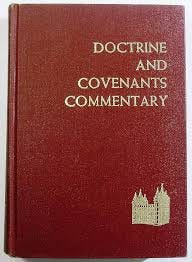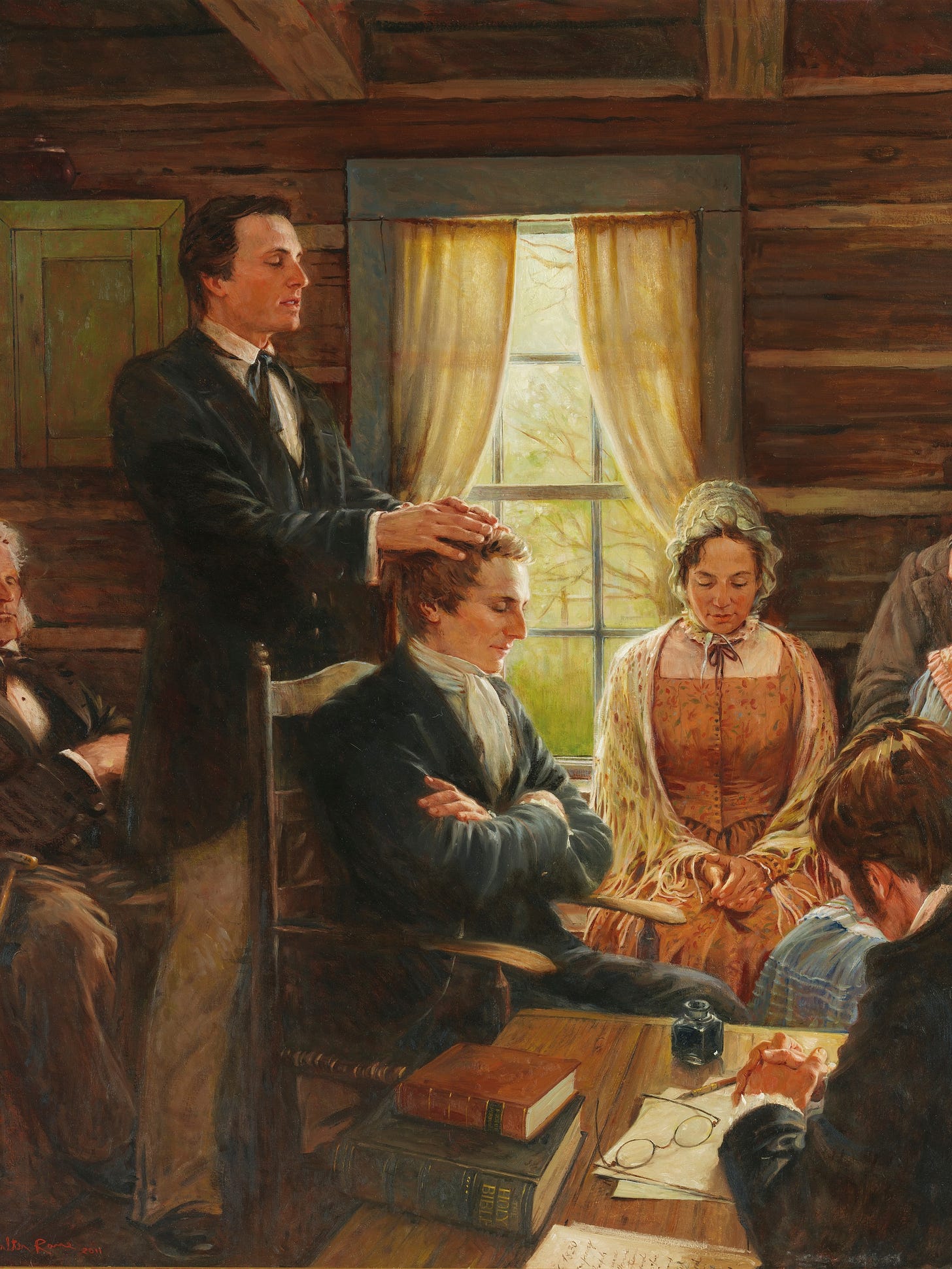A Rebuke, a Mission Call, and Service in the Church
Background Information and Reflections on Doctrine and Covenants Section 30
For an excellent discussion regarding the Millennium, Zion, the New Jerusalem, the Fall, and Theories vs. Doctrine of Sin, consult Smith and Sjodahl’s General Notes on D&C 29, pp. 159-161.
Today is April 6, 2025. The Church of Jesus Christ of Latter-day Saints was Restored exactly 195 years ago. In five more years, we will celebrate the bicentennial of the restoration of the Lord’s Church.
In the meantime, this week, we are still learning about the foundations of the Church of Jesus Christ of Latter-day Saints in Doctrine and Covenants 30-36. Seven sections in seven days is probably a good pace for studying this portion of the Doctrine and Covenants, but there are several new characters to introduce, and several important events to record. The LDS Come Follow Me manual contains a brief introduction to these characters and events:
Parley P. Pratt had been a member of the Church for about a month when he was called “into the wilderness” to preach the gospel (Doctrine and Covenants 32:2). Thomas B. Marsh had been a member for even less time than that when he was told, “The hour of your mission is come” (Doctrine and Covenants 31:3). Orson Pratt, Edward Partridge, and many others had likewise barely been baptized when their mission calls came. Perhaps there’s a lesson in this pattern for us today: if you know enough to accept the restored gospel by baptism, you know enough to share it with others. Of course, we always want to increase our gospel knowledge, but God has never hesitated to call upon the “unlearned” to preach His gospel (Doctrine and Covenants 35:13). In fact, He invites all of us, “Open your mouth to declare my gospel” (Doctrine and Covenants 30:5). And we do that best not through our own wisdom and experience but “by the power of [the] Spirit” (Doctrine and Covenants 35:13).
See also “The Faith and Fall of Thomas Marsh,” “Ezra Thayer: From Skeptic to Believer,” “Orson Pratt’s Call to Serve,” in Revelations in Context, 54–69.
In addition to Parley P. Pratt, his younger brother Orson Pratt, Thomas B. Marsh, and Edward Partridge, in D&C sections 30-36 we also learn of Ziba Peterson, Ezra Thayre, Northrup Sweet, and Sidney Rigdon, among others. The efforts of these early converts to invite all to come unto Christ and to minister to others can inspire us in our own efforts to share the Gospel and to serve the Lord. Let’s pick up where we left off in the timeline of the early Restoration:
Sept. 26-29, 1830
The second conference of the Church is held at Fayette, N.Y., 62 members attend. On the first day there is much disagreement and discussion about Hiram Page’s seer stone but the Church votes unanimously to sustain Joseph Smith. Joy unspeakable and the manifestations of the Holy Ghost attend the three-day conference. Durning this conference Joseph receives revelations for John, David, and Peter Whitmer, Jr., and Thomas B. Marsh. (See D&C 30, 31)
Fall 1830
After the conference Hyrum goes to Colesville with his family on his mission. The day he leaves, Joseph Smith, Sr. is imprisoned because of a $14 debt owed to a Quaker. The man offers to forgive the Prophet’s father if he will renounce the Book of Mormon, but he refuses. A mob threatens the home of Lucy Mack Smith, but she is saved when 19-year-old William returns and scares the mob away. Joseph, Sr., ends up spending 30 days in jail, but he preaches the gospel while there and converts two men.
Oct. 1830
Joseph receives D&C 32, instructing Parley P. Pratt and Ziba Peterson to accompany Oliver Cowdery and Peter Whitmer on their mission to the Lamanites in the wilderness. These four missionaries leave and preach to Indians near Buffalo, then travel 200 miles unto they reach the area of Kirtland, Ohio. Joseph also receives D&C 33.
Oct. 15, 1830
The four missionaries arrive in Mentor, Ohio, and introduce the gospel to Sidney Rigdon. Within a week they preach in Mentor, Euclid, and Kirtland and baptize 17. Sidney Rigdon refuses to debate his former follower, Parley P. Pratt, but agrees to study the Book of Mormon alone, and after two weeks Rigdon also is converted.
Oct. 21, 1830
Joseph translates Gen. 5:28-37, which become Moses 5:43-51. The translation of Genesis continues sporadically throughout the following three years.
Oct. 31, 1830
The four missionaries in Kirtland move from Sidney Rigdon’s home to the communal family farm of Isaac Morley and there confirm a dozen more members in the Church in Kirtland.
Nov. 4, 1830
Orson Pratt comes to meet Joseph. Joseph receives D&C 34 for him.
Nov. 7, 1830
Missionaries confirm about 30 more new members in Mayfield, Ohio. By this time they have also baptized Sidney Rigdon’s friend John Murdock and Dr. Frederick G. Williams, who gives them cash and a horse and accompanies them on their mission to the Lamanites.
About Nov. 20, 1830
The missionaries leave three branches of the Church in Ohio, having baptized about 130 people. Kirtland is presided over by Lyman Wight (another former follower of Rigdon), Warrensville by John Murdock, Mentor by Sidney Rigdon. (The on disciple of Rigdon whom they were not able to convert was Orson Hyde, who preached against the Book of Mormon for awhile and was not baptized until Oct. 30, 1831.
Dec. 10, 1830
Sidney Rigdon and Edward Partridge, a successful Painesville hatter, arrive in Fayette from Kirtland to meet Joseph. Joseph later writes that Partridge is “a pattern of piety and one of the Lord’s great men.” (HC 1:128)
Dec 11, 1830
Joseph baptizes E. Partridge. (HC 1:129)
Mid-Dec. 1830
In response to a visit from Sidney Rigdon and Edward Partridge (see Dec. 10, below), the Lord reveals to Joseph D&C 35 and 36. To encourage the small flock of 70 members in Colesville and surrounding areas, the Lord reveals to Joseph some of the lost books of the Bible. Joseph records the Prophecy of Enoch (what is now Moses 7:1-69). Joseph also receives D&C 37.
J. Christopher Conkling, A Joseph Smith Chronology, pp. 18-20
Let’s also begin with the more specific background for D&C section 30:
Date. September 1830 (before 26 September, according to “Far West Record,” p. 2).
Place. Fayette, Seneca County, New York.
Historical Note. Section 30, given to David, Peter, Jr., and John Whitmer at Fayette, New York, was originally three separate revelations in the Book of Commandments. Among other matters, section 30 called Peter Whitmer, Jr., to accompany Oliver Cowdery on his mission to the Lamanites.
Publication Note. Section 30 was first published as chapters 31, 32, and 33 in the Book of Commandments in 1833.
Biographical Note. Philip Burroughs.
Son of Jonathan Burroughs. Born in New Hampshire about 1795. Elected “overseer of the highways and fence viewer” for Junius, Seneca County, New York, April 1819. Residing in Seneca Falls, Seneca County, New York, 1830. Church meeting held in home September 1830. Apparently, which his wife, member of the Church.
Lyndon W. Cook, The Revelations of the Prophet Joseph Smith, pp. 41-42)
In a previous post we learned about the first mission to the Lamanites. In D&C 30, the Lord chastises David Whitmer for his failure to serve diligently, He calls Peter Whitmer Jr. to accompany Oliver Cowdery on a mission to the Lamanites, and John Whitmer is also called to preach the Gospel. Joseph Smith received this revelation following the three-day conference at Fayette, but before the elders of the Church had separated. Because this material was originally published as three separate revelations, let us examine each revelation, one at a time.
The Revelation to David Whitmer
Behold, I say unto you, David, that you have feared man and have not relied on me for strength as you ought.
But your mind has been on the things of the earth more than on the things of me, your Maker, and the ministry whereunto you have been called; and you have not given heed unto my Spirit, and to those who were set over you, but have been persuaded by those whom I have not commanded.
Wherefore, you are left to inquire for yourself at my hand, and ponder upon the things which you have received.
And your home shall be at your father’s house, until I give unto you further commandments. And you shall attend to the ministry in the church, and before the world, and in the regions round about. Amen. (D&C 30:1-4)
This is a great reminder of what not to do:
Don’t fear man
Don’t rely on your own strength instead of relying on on the Lord for strength
Don’t focus on the things of the earth more than on the things of God
Don’t ignore the Spirit and righteous leaders
Don’t be persuaded by those whom the Lord has not commanded
Because David Whitmer feared man, relied on his own strength, focused on the things of the earth, ignored the Spirit and leaders, and was persuaded by those whom the Lord had not commanded, his progress was hindered for a time. It appears as though, spiritually speaking, the Lord sent him to his room. The Lord chastened him and corrected him because He loved him.
The Smith and Sjodahl commentary on this section and these verses is helpful:
There is some discrepancy in the records regarding the date of the second Conference of the Church, but Elder B. H. Roberts, in History of the Church, Vol. I. p. 110, gives sufficient reasons for accepting the 26th of September, 1830, rather than the first of that month, as the correct date. When this Conference convened, the question of the seer-stone of Hiram Page was discussed. The error was thoroughly exposed and acknowledged (Sec. 28:11), and harmony and unity were fully restored. The Saints partook of the Sacrament, and the Spirit of the Lord was poured out upon them in abundant measure. While the conference was still in session this Revelation and the following were received.
This Revelations contains three sections; one is addressed to David Whitmer, one to Peter Whitmer, Jr., and one to John Whitmer.
1-4. David Whitmer is mildly rebuked for listening to Hiram Page, and perhaps for using his influence over other members of the family in favor of the supposed seer-stone. He was told that he had feared man, and set his mind on earthly things, instead of taking care of the ministry and listening to the Spirit and the inspired Prophet, with the result that he had been left to inquire for himself; the Prophet could not inquire for him. He was also commanded to remain at home, until further instruction should be given, and confine his labors, for the time being, to the Church and the world in the neighborhood. Deviation from the narrow path always brings with it some consequences which remain after the sin has been pardoned. See also notes, Sec. 14.
The Revelation to Peter Whitmer, Jr.
Behold, I say unto you, Peter, that you shall take your journey with your brother Oliver; for the time has come that it is expedient in me that you shall open your mouth to declare my gospel; therefore, fear not, but give heed unto the words and advice of your brother, which he shall give you.
And be you afflicted in all his afflictions, ever lifting up your heart unto me in prayer and faith, for his and your deliverance; for I have given unto him power to build up my church among the Lamanites;
And none have I appointed to be his counselor over him in the church, concerning church matters, except it is his brother, Joseph Smith, Jun.
Wherefore, give heed unto these things and be diligent in keeping my commandments, and you shall be blessed unto eternal life. Amen. (D&C 30:5-8)
Oliver Cowdery was the senior companion with more experience in the Gospel and wisdom to share. There are good reasons for sending missionaries out two by two, or in groups of four. The Lord endowed Oliver Cowdery with power to build up His church among the Lamanites, and Oliver Cowdery was second in command only to Joseph Smith. Notice how the Lord calls Joseph Smith Oliver Cowdery’s brother. Special bonds of brotherhood are formed through service in the Church and especially through missionary work. The Lord blessed Peter Whitmer, Jr. and promised him great things, even the greatest of all blessings, according to his diligence and obedience.
This is the Smith and Sjodahl commentary on these verses:
5-8. Peter Whitmer is not rebuked. He, in all probability, was innocent in the matter of the seer-stone. He was called to go with Oliver Cowdery on the long and perilous mission to the Lamanites (Sec. 28:8), and he was admonished to give heed to him, follow his advice, share with him the trials and sufferings before him, and always pray and exercise faith. If he would do these things and keep God’s commandments, he would have eternal life. Missionary labor is complete only when the missionary is willing to follow counsel and keep the commandments of God. See notes, Sec. 16.
The Revelation to John Whitmer
Behold, I say unto you, my servant John, that thou shalt commence from this time forth to proclaim my gospel, as with the voice of a trump.
And your labor shall be at your brother Philip Burroughs’, and in that region round about, yea, wherever you can be heard, until I command you to go from hence.
And your whole labor shall be in Zion, with all your soul, from henceforth; yea, you shall ever open your mouth in my cause, not fearing what man can do, for I am with you. Amen. (D&C 30:9-11)
With the voice of a trump? Liberals in the Church must really dislike any verses of scripture that mention a trump. 😂
John Whitmer’s mission and ministry was just beginning, and the Lord specified exactly where and with whom to begin. I especially love the last verse in this section. Notice that the Lord commanded John Whitmer to labor in Zion, even though the place of the city of Zion, the New Jerusalem, had not yet been revealed.
This is the Smith and Sjodahl commentary on these verses:
9-11. John Whitmer is called at this time to labor especially among the Saints. He was very active in the Church as an aid to the Prophet. He assisted in the compilation of the Revelations, and accompanied Oliver Cowdery to Jackson County to superintend the printing of them. He was one of the seven High Priests appointed to preside in the Church in Jackson County. He was the Church historian and editor of important Church publications. But he did not remain faithful. See notes Sec. 15.








